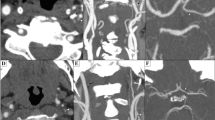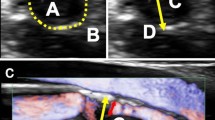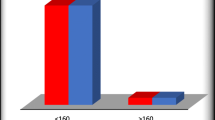Abstract
Background and purpose: There are several possible sources of cerebral embolic ischaemia distal to an occlusion of the internal carotid artery (ICA). Our aim was to identify the source of microembolic signals in the ipsilateral middle cerebral artery (MCA) by taking simultaneous bitemporal transcranial Doppler ultrasound recordings of the ipsilateral MCA and the contralateral ACA to find the route of potential microembolic material to MCA. Subjects and methods: The study group consisted of 38 patients with an occlusion of the ICA. With extracranial duplex sonography (ACUSON 128 XP; 7 MHz), performed by an experienced sonographer, the echo intensity and echo structure of the occluded ICA in the extracranial part (proximal) were classified as homogeneous or inhomogeneous. In addition, affected segments of the ipsilateral and contralateral carotid artery with arteriosclerotic vessel walls were compared. Microembolic signals were recorded with transcranial Doppler (TCD) monitoring. The microemboli counts in the MCA and ACA were added to the sum scores. Results: The number of affected segments of the carotid artery on the ipsilateral (the bifurcation, the external or common carotid artery) and contralateral side of occluded ICA were equally distributed. In ipsilateral MCA 3.1, 7.1 microemboli (average mean, SD) with a range of between 0 and 34 were counted, in the contralateral ACA 0.3, 0.6 (range of between 0 and 2). Regression analysis confirmed the non-predictability of the microemboli variance on the ipsilateral side of the occlusion from the variance on the contralateral side (multiple r: 0.024). We found no significant correlation between the echo intensity or echo structure of the occluded artery and an increased rate of microemboli in the ipsilateral MCA. Conclusions: Our results indicate a predominantly ipsilateral source for cerebral microemboli in ICA occlusion. The rate of cerebral microembolic signals was not influenced by the echo structure and echo intensity of the occluded ICA.
Similar content being viewed by others
Author information
Authors and Affiliations
Additional information
Received: 24 May 1996 Received in revised form: 20 January 1997 Accepted: 31 January 1997
Rights and permissions
About this article
Cite this article
Delcker, A., Diener, H. & Wilhelm, H. Source of cerebral microembolic signals in occlusion of the internal carotid artery. J Neurol 244, 312–317 (1997). https://doi.org/10.1007/s004150050093
Issue Date:
DOI: https://doi.org/10.1007/s004150050093




